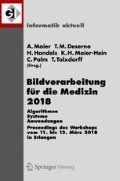Zusammenfassung
The patient surface model has shown to be a useful asset to improve existing diagnostic and interventional tasks in a clinical environment. For example, in combination with RGB-D cameras, a patient surface model can be used to automate and accelerate the diagnostic imaging workflow, manage patient dose, and provide navigation assistance. A shortcoming of today’s patient surface models, however, is that, internal anatomical landmarks are not present. In this paper, we introduce a method to estimate internal anatomical landmarks based on the surface model of a patient. Our method relies on two major steps. First, we fit a template surface model is to a segmented surface of a CT dataset with annotated internal landmarks using keypoint and feature descriptor based rigid alignment and atlas-based non-rigid registration. In a second step, we find for each internal landmark a neighborhood on the template surface and learn a generalized linear embedding between neighboring surface vertices in the template and the internal landmark. We trained and evaluated our method using cross-validation in 20 datasets over 50 internal landmarks. We compared the performance of four different generalized linear models. The best mean estimation error over all the landmarks was achieved using the lasso regression method with a mean error of 12.19 ± 6.98 mm.
Access this chapter
Tax calculation will be finalised at checkout
Purchases are for personal use only
Preview
Unable to display preview. Download preview PDF.
Literatur
Singh V, Chang Y, Ma K, et al. Estimating a patient surface model for optimizing the medical scanning workflow. Proc MICCAI. 2014; p. 472–479.
Johnson PB, Borrego D, Balter S, et al. Skin dose mapping for fluoroscopically guided interventions. Med Phys. 2011;38(10):5490–5499.
Bauer S, Wasza J, Haase S, et al. Multi-modal surface registration for markerless initial patient setup in radiation therapy using Microsoft’s kinect sensor. Proc IEEE ICCV. 2011; p. 1175–1181.
Anguelov D, Koller D, Pang HC, et al. Recovering articulated object models from 3D range data. Uncertain Artif Intell. 2004; p. 18–26.
5. Zhong X, Strobel N, Kowarschik M, et al. Comparison of default patient surface model estimation methods. Proc BVM. 2017; p. 281–286.
Darom T, Keller Y. Scale-invariant features for 3-D mesh models. IEEE Trans Image Process. 2012;21(5):2758–2769.
Sahillioğlu Y, Yemez Y. Minimum-distortion isometric shape correspondence using EM algorithm. IEEE Trans Pattern Anal Mach Intell. 2012;34(11):2203–2215.
Allen B, Curless B, Popović Z. The space of human body shapes: reconstruction and parameterization from range scans. ACM Trans Graph. 2003;22(3):587–594.
Roweis ST, Saul LK. Nonlinear dimensionality reduction by locally linear embedding. Science. 2000;290(5500):2323–2326.
del Toro OAJ, Goksel O, Menze B, et al. VISCERAL: visual concept extraction challenge in radiology. Proc VISCERAL Challenge at ISBI. 2014; p. 6–15.
Author information
Authors and Affiliations
Corresponding author
Editor information
Editors and Affiliations
Rights and permissions
Copyright information
© 2018 Springer-Verlag GmbH Deutschland
About this paper
Cite this paper
Zhong, X., Strobel, N., Birkhold, A., Kowarschik, M., Fahrig, R., Maier, A. (2018). Patient Surface Model and Internal Anatomical Landmarks Embedding. In: Maier, A., Deserno, T., Handels, H., Maier-Hein, K., Palm, C., Tolxdorff, T. (eds) Bildverarbeitung für die Medizin 2018. Informatik aktuell. Springer Vieweg, Berlin, Heidelberg. https://doi.org/10.1007/978-3-662-56537-7_27
Download citation
DOI: https://doi.org/10.1007/978-3-662-56537-7_27
Published:
Publisher Name: Springer Vieweg, Berlin, Heidelberg
Print ISBN: 978-3-662-56536-0
Online ISBN: 978-3-662-56537-7
eBook Packages: Computer Science and Engineering (German Language)

